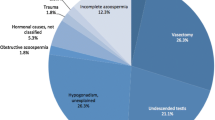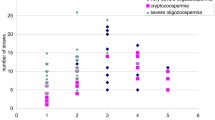Abstract
Purpose: To show whether increased amounts of spermatozoa used in insemination of preovulatory oocytes in isolated teratozoospermia according to Kruger's strict criteria gives good fertilization rates.
Methods: This study was carried out from September 1993 to November 1994 for a total of 77 cycles, with sperm samples classified according to Kruger's strict classification. Group 1 (C; control) included 37 couples with normal sperm morphology (>14% normal; SC). Group 2 (GP; good prognosis) included 18 couples (morphology, ≥4 and ≤14% normal) and group 3 (T; teratozoospermic) included 11 couples, with isolated teratozoospermia in the male partner (morphology, <4% normal).
Results: No statistically significant difference was seen in the three groups regarding age, duration of infertility, aspirated follicles, oocytes collected, and embryos transferred. There is a statistically significantly difference (P<0.001) in the number of spermatozoa used in insemination in group 3.
Conclusions: In conclusion, a morphological classification using strict criteria in the assessment of sperm morphology is still very important, as increasing the sperm number of spermatozoa inseminated per oocyte may improve zona pellucida binding and give better IVF results.
Similar content being viewed by others
References
World Health Organization: WHO Laboratory Manual for the Examination of Human Semen and Sperm-Cervical Mucus Interactions, 3rd ed. Cambridge, Press Syndicate University of Cambridge, 1992, pp 3–27
Kruger TF, Menkveld R, Stander FSH, Lombard CJ, Van der Merwe JP, Van Zyl JA, Smith K: Sperm morphologic features as a prognostic factor in in vitro fertilization. Fertil Steril 1986;46:1118–1123
Kruger TF, Acosta AA, Simmons KF, Swanson RJ, Matta JF, Veeck LL, Morshedi M, Brugo S: New method of evaluating sperm morphology with predictive value for human in vitro fertilization. Urology 1987;30:248–251
Kruger TF, Acosta AA, Simmons KF, Swanson RJ, Matta JF, Oehninger S: Predictive value of abnormal sperm morphology in in vitro fertilization. Fertil Steril 1988;49:112–117
Menkveld R, Stander FSH, Kotze TJW, Kruger TF, Van Zyl JA: The evaluation of morphological characteristics of human spermatozoa according to stricter criteria. Hum Reprod 1990;5:586–592
Chang SYW, Wang C, Chan STH, Ho PC, So WWK, Chan YF, Ma HK: Predictive value of sperm morphology and movement characteristics in the outcome of in vitro fertilization of human oocytes. J Vitro Fertil Embryo Transfer 1988;6:142–148
Enginsu ME, Dumoulin JCM, Pieters MHEC, Bras M, Evers JLH, Geraedts JPM: Evaluation of human sperm morphology using strict criteria after Diff-Quik staining: correlation of morphology with fertilization in vitro. Hum Reprod 1991;6:854–858
Ombelet W, Fourie FR, Vandeput H, Bosmans E, Cox A, Janssen M, Kruger T: Teratozoospermia and in-vitro fertilization: a randomized prospective study. Hum Reprod 1994;9:1479–1484
Veeck LL, Maloney M: Insemination and fertilization.In In Vitro Fertilization-Norfolk, HW Jones Jr, GS Jones, GD Hodgen, Z Rosenwalks, eds. Baltimore, Williams & Wilkins, 1986, p 168
Veeck LL, Wortham JWE, Witmyer JE, Sandow BA, Acosta AA, Garcia JE, Jones GS, Jones HW: Maturation and fertilization of morphologically immature human oocytes in a program of in vitro fertilization. Fertil Steril 1983;39:594–602
Papanicolaou GN: A new procedure for staining of vaginal smears. Science 1942;95:438
Veeck LL.In Atlas of the Human Oocyte and Early Conceptus, CL Brown (ed.) Baltimore, Williams and Wilkins, 1986, pp 5–139
Ord T, Patrizio P, Balmaceda JP, Asch RH: Can severe male factor infertility be treated without micromanipulation? Fertil Steril 1993;60:100–115
Ord T, Patrizio P, Marello E, Balmaceda JP, Asch RH: Mini-Percoll: A new method of sperm preparation for IVF in severe male factor infertility. Hum Reprod 1990;5:987–989
Oehninger S, Acosta AA, Morshedi M, Veeck LL, Swanson RJ, Simmons K, Rosenwaks Z: Corrective measures and pregnancy outcome in in vitro fertilization in patients with severe sperm morphology abnormalities. Fertil Steril 1988;50:283–287
Robinson NJ, Lockwood MG, Dokras A, Egan D, Nicholson CS, Ross C, Barlow DH: Does isolated teratozoospermia affect performance in in-vitro fertilization and embryo transfer? Hum Reprod 1994;9:870–874
Franken DR, Kruger TF, Menkveld R, Oehninger S, Coddington CC, Hodgen GD: Hemizona assay and teratozoospermia: increasing sperm insemination concentration to enhance zona pellucida binding. Fertil Steril 1990;54:497–503
Hammit D: Treatment of male factor infertility by in vitro insemination with high concentration of motile sperm. Sem Reprod Endocrinol 1993;11:72–82
Jones HW Jr, Acosta AA, Andrews MC, Garcia JE, Jones GS, Mayer J,et al. Three years of in vitro fertilization at Norfolk. Fertil Steril 1984;41:826–834
Author information
Authors and Affiliations
Rights and permissions
About this article
Cite this article
Figueiredo, H., Tavares, A., Ferrás, L. et al. Isolated teratozoospermia and in vitro fertilization. J Assist Reprod Genet 13, 64–68 (1996). https://doi.org/10.1007/BF02068872
Received:
Accepted:
Issue Date:
DOI: https://doi.org/10.1007/BF02068872




